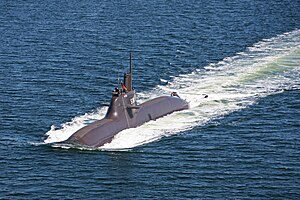Type 212 submarine

U-34 underway
|
|
| Class overview | |
|---|---|
| Builders: | Howaldtswerke-Deutsche Werft GmbH (HDW) - Fincantieri SpA |
| Operators: | |
| Preceded by: | Type 206 submarine, Sauro class submarine |
| Cost: | 371 million Euros |
| In service: | 2002 |
| In commission: | 2005 |
| Planned: | 14 |
| Completed: | 10 |
| Active: | 8 |
| General characteristics | |
| Displacement: |
|
| Length: |
|
| Beam: | 6.80 metres (22 ft 4 in) |
| Draught: | 6.40 metres (21 ft 0 in) |
| Decks: | 2 |
| Installed power: | 1 x MTU-396 16V (2,150 kW); 1 x Siemens Permasyn electric motor Type FR6439-3900KW (2,850 kW) |
| Propulsion: |
|
| Speed: |
|
| Range: | 8,000 nautical miles (15,000 km; 9,200 mi) at 8 knots (15 km/h; 9.2 mph) |
| Endurance: | 3 weeks without snorkeling, 12 weeks overall |
| Test depth: |
|
| Complement: | 5 officers, 22 men |
| Sensors and processing systems: |
CSU 90 (DBQS-40FTC), Sonar: ISUS90-20, Radar: Kelvin Hughes Type 1007 I-band nav., |
| Electronic warfare & decoys: |
EADS FL 1800U suite |
| Armament: | 6 x 533 millimetres (21 in) torpedo tubes (in 2 forward pointing groups of 3) with 13DM2A4, Black Shark Torpedo, IDAS missiles and 24 external naval mines (optional) |
The German Type 212 class, also Italian Todaro class, is a highly advanced design of non-nuclear submarine developed by Howaldtswerke-Deutsche Werft AG (HDW) for the German and Italian navies. It features diesel propulsion and an additional air-independent propulsion (AIP) system using Siemens proton exchange membrane (PEM) compressed hydrogen fuel cells. The submarines can operate at high speed on diesel power or switch to the AIP system for silent slow cruising, staying submerged for up to three weeks without surfacing and with little exhaust heat. The system is also said to be vibration-free, extremely quiet and virtually undetectable.
Type 212 is the first fuel cell propulsion system equipped submarine series.
At the beginning of the 1990s the German Navy was seeking a replacement for the Type 206 submarines. Initial study started on a Type 209 improved design, with AIP capability, called Type 212.
The final programme started in 1994 as the two navies of Germany and Italy began working together to design a new conventional submarine, respectively to operate in the shallow and confined waters of the Baltic Sea and in the deeper waters of the Mediterranean Sea. The two different requirements were mixed into a common one and, because of significant updates to the design, the designation has been changed to Type 212A since then.
On 22 April 1996 a Memorandum of Understanding (MOU) gave the start to the cooperation for building four vessels for German Navy and four vessels for Italian Navy. Its main aim was the construction of identical boats and the start of a collaboration in logistic and life-cycle support for the two navies.
...
Wikipedia
